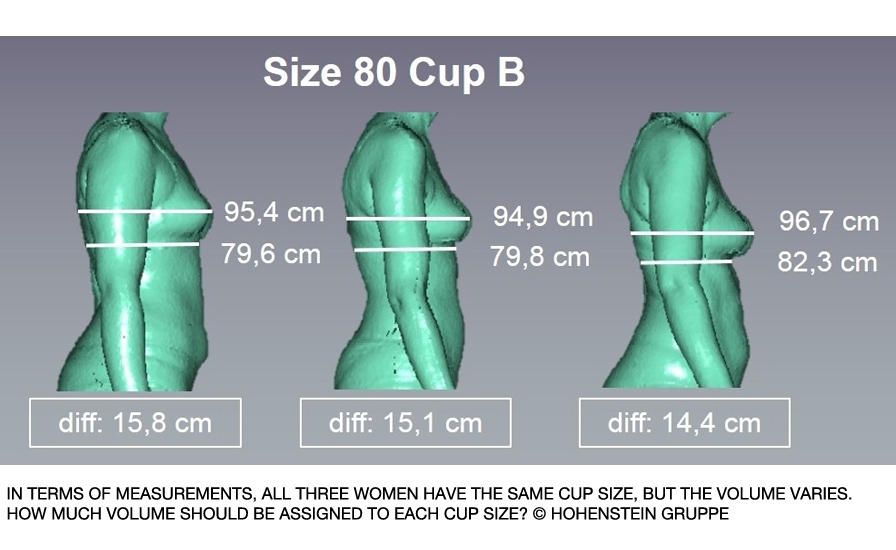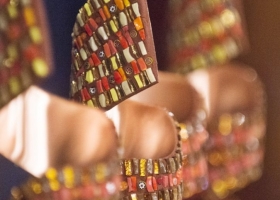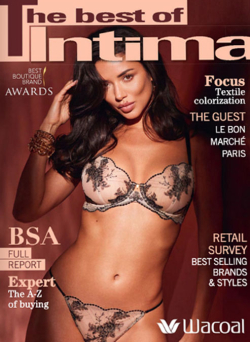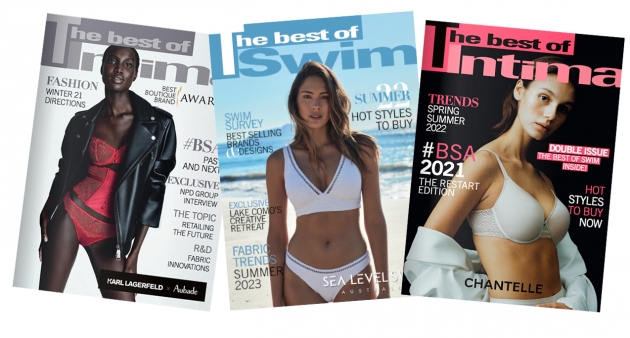
The Best ofIntima & Swim Edit
BRA SIZING WITH THE HOHENSTEIN INSTITUTE Volume VS Circumference
24 August 2017
THE HOHENSTEIN INSTITUTE HAS SET OUT TO CREATE A NEW APPROACH TO BREAST-CUP-SIZING DETERMINED BY BREAST VOLUME RATHER THAN THE TRADITIONAL CIRCUMFERENCE METHOD.


In 2001 The Hohenstein Underwear
Project measured and interviewed 1,500
women. The results established that
more than 50% of women were wearing the wrong
bra size. Similar surveys in Australia and the UK
have shown that figure to be as high as over 80%. A
survey by Van de Velde Lingerie in 2011 found the
figure to be 70%, while the American underwear
manufacturer Jockey International announced in
spring 2013, when it introduced a new sizing system
for its own bras, that it was working on the basis
that 80% of women wear badly fitting bras. While
the figure varies, the experts seem sure of one
thing: a very high
percentage of women are
wearing a badly fitting bra.
German research group,
The Hohenstein Institute
has set out to combat this
problem with their new
take on how to determine
breast size. The Best of
Intima was lucky enough to
have Simone Morlock, a
specialist at the Hohenstein
Institute, tell us more
about this exciting project.

Why do we have a problem with bra sizing? The existing system of bra sizing does not allow the cup size to be determined by breast volume. One reason for this problem is that women who have the same circumference measurements and breast circumferences sometimes have very different body proportions. This means that, even though the dimensions may be the same, the cup volume and shape of the breast may vary significantly. Different underwear manufacturers use different cup sizes because of the lack of information about breast volume. Customers are therefore unable to find standard sizes in the shops. Consequently retailers, especially in the mail order and online businesses, experience lots of problems and returns in relation to these products. The problem of the lack of standard sizing is one of the main reasons why most women wear badly or incorrectly fitting bras.

What type of health
problems can occur due
to a badly fitting bra?
90% of all women
wear a bra every day. So
this is a large and important market with huge commercial potential.
However, the manufacturers face the particular
challenge of having to develop properly-fitting
underwear products for women of all sizes, body
types and age groups, and trying to meet market
requirements. The main problem is that traditional
measuring methods don't take account of the actual
volume of the breast. That's why a new way of
defining cup size is required.
Which demographic took part?
At Hohenstein we have a pool of data from about
12,000 3D-scans of women, the result of various size
surveys in Germany since 1999. These formed the
basis for the research work on cup sizes. The
random sample covers an age range from 18 to 80
years and cup sizes from AA to J. The sample
includes everyone from very slim women to plussize
women, and so represents a very good basis for
anthropometric study.

Can you explain your new approach?
Our innovative solution includes developing a
new state-of-the-art method that allows the cup size
to be determined in relation to breast volume.
The results of the research are in the form of data
about breast volume and new breast measurements,
which can be used to supplement and update
existing traditional size charts for foundation
garments. The researchers also developed virtual 3D
cup models for visualizing cup sizes and used them
to construct volume-based 3D basic patterns. The
results also show the extent to which successful
marketing of foundation garments depends on both
the product and the target market. There can never
be one standard solution that is suitable for all
circumstances.
The new findings from the project describe the
specific sizing requirements for foundation
garments and cup-based clothing products, and
constitute an important basis for further
development. They will help to improve the fit of
products, assist customers in finding the right size
and reduce high product development costs.
The
virtual breast models that have been developed also
provide useful fitting principles for use in 3D
simulation and design systems.
Who do you think can benefit from your project?
The research results describe the basic
principles which are need to be taken into account
when developing, producing and marketing
foundation garments and cup-based clothing
products. However, it is not only the manufacturers
of underwear, orthopedic items and ladies'
outerwear who will benefit. It will also be to the
advantage of customers themselves if the results of
the research can be used to develop and market bra
shapes that are more adapted to customers' body
shapes. It will be easier for them to find the right
size in the shops and, secondly, it will help ensure
that more women wear a correctly fitting bra. The
researchers hope that, in the long term, typical
health problems such as skin irritation, shoulder and
back problems and shoulder strain caused by badly
fitting bras can be avoided.
Copyright 2025. All right reserved - Terms








